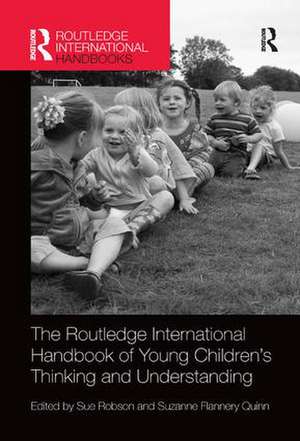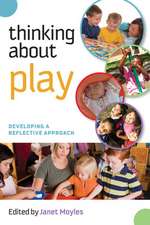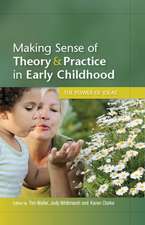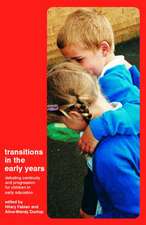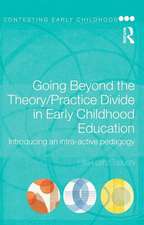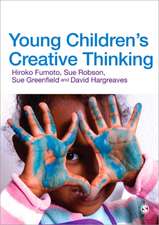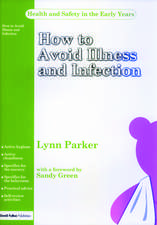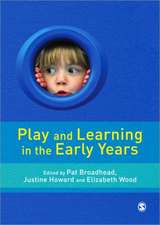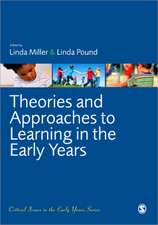The Routledge International Handbook of Young Children’s Thinking and Understanding: Routledge International Handbooks of Education
Editat de Sue Robson, Suzanne Flannery Quinnen Limba Engleză Paperback – 12 oct 2017
The handbook is organised into four complementary parts:
• How can we think about young children’s thinking?: Concepts and contexts
• Knowing about the brain and knowing about the mind
• Making sense of the world
• Documenting and developing children’s thinking
Supported throughout with relevant research and case studies, this handbook is an international insight into the many ways there are to understand children and childhood paired with the knowledge that young children have a strong, vital, and creative ability to think and to understand, and to create and contend with the world around them.
| Toate formatele și edițiile | Preț | Express |
|---|---|---|
| Paperback (1) | 455.78 lei 6-8 săpt. | |
| Taylor & Francis – 12 oct 2017 | 455.78 lei 6-8 săpt. | |
| Hardback (1) | 1559.82 lei 6-8 săpt. | |
| Taylor & Francis – 11 noi 2014 | 1559.82 lei 6-8 săpt. |
Din seria Routledge International Handbooks of Education
-
 Preț: 385.13 lei
Preț: 385.13 lei -
 Preț: 340.74 lei
Preț: 340.74 lei - 9%
 Preț: 1491.01 lei
Preț: 1491.01 lei -
 Preț: 341.07 lei
Preț: 341.07 lei -
 Preț: 334.03 lei
Preț: 334.03 lei - 9%
 Preț: 1594.04 lei
Preț: 1594.04 lei -
 Preț: 367.55 lei
Preț: 367.55 lei -
 Preț: 471.80 lei
Preț: 471.80 lei - 12%
 Preț: 331.87 lei
Preț: 331.87 lei - 12%
 Preț: 331.87 lei
Preț: 331.87 lei -
 Preț: 422.58 lei
Preț: 422.58 lei - 29%
 Preț: 1185.83 lei
Preț: 1185.83 lei -
 Preț: 416.22 lei
Preț: 416.22 lei -
 Preț: 466.02 lei
Preț: 466.02 lei - 18%
 Preț: 1574.36 lei
Preț: 1574.36 lei - 22%
 Preț: 455.27 lei
Preț: 455.27 lei - 11%
 Preț: 302.55 lei
Preț: 302.55 lei - 12%
 Preț: 331.87 lei
Preț: 331.87 lei - 12%
 Preț: 331.87 lei
Preț: 331.87 lei - 25%
 Preț: 541.50 lei
Preț: 541.50 lei - 26%
 Preț: 1830.09 lei
Preț: 1830.09 lei - 25%
 Preț: 1194.82 lei
Preț: 1194.82 lei - 18%
 Preț: 1568.21 lei
Preț: 1568.21 lei - 11%
 Preț: 341.86 lei
Preț: 341.86 lei - 18%
 Preț: 1554.29 lei
Preț: 1554.29 lei - 24%
 Preț: 426.49 lei
Preț: 426.49 lei - 15%
 Preț: 572.34 lei
Preț: 572.34 lei - 18%
 Preț: 1557.14 lei
Preț: 1557.14 lei - 18%
 Preț: 1617.55 lei
Preț: 1617.55 lei -
 Preț: 455.78 lei
Preț: 455.78 lei - 18%
 Preț: 1571.83 lei
Preț: 1571.83 lei - 15%
 Preț: 567.41 lei
Preț: 567.41 lei - 11%
 Preț: 343.25 lei
Preț: 343.25 lei - 31%
 Preț: 1689.67 lei
Preț: 1689.67 lei - 11%
 Preț: 339.94 lei
Preț: 339.94 lei
Preț: 455.78 lei
Nou
Puncte Express: 684
Preț estimativ în valută:
87.21€ • 91.06$ • 72.02£
87.21€ • 91.06$ • 72.02£
Carte tipărită la comandă
Livrare economică 15-29 aprilie
Preluare comenzi: 021 569.72.76
Specificații
ISBN-13: 9781138577213
ISBN-10: 1138577219
Pagini: 544
Ilustrații: 19 Line drawings, black and white; 40 Halftones, black and white; 11 Tables, black and white; 59 Illustrations, black and white
Dimensiuni: 156 x 234 x 38 mm
Greutate: 0.45 kg
Ediția:1
Editura: Taylor & Francis
Colecția Routledge
Seria Routledge International Handbooks of Education
Locul publicării:Oxford, United Kingdom
ISBN-10: 1138577219
Pagini: 544
Ilustrații: 19 Line drawings, black and white; 40 Halftones, black and white; 11 Tables, black and white; 59 Illustrations, black and white
Dimensiuni: 156 x 234 x 38 mm
Greutate: 0.45 kg
Ediția:1
Editura: Taylor & Francis
Colecția Routledge
Seria Routledge International Handbooks of Education
Locul publicării:Oxford, United Kingdom
Public țintă
Postgraduate and UndergraduateCuprins
Part 1 How can we think about young children’s thinking?: concepts and contexts 1. The Infant’s Creative Vitality, In Projects of Self-Discovery and Shared Meaning: How They Anticipate School, and Make It Fruitful Colwyn Trevarthen and Jonathan Delafield-Butt 2. 'I wonder why our dog has been so naughty?': Thinking differently from the perspective of play Elizabeth Wood 3. How Play Creates the Zone of Proximal Development Pentti Hakkarainen and Milda Brėdikytė 4. Developing Implicit Social Cognition in Early Childhood: Methods, Phenomena, Prospects Dario Cvencek and Andrew N. Meltzoff 5. The organisation of memory and thought: Where the boundaries of now meet the boundaries of me Suzanne Flannery Quinn 6. The development of children’s causal explanations Cristine H. Legare and Jennifer M. Clegg 7. Development of the Use of Agents as Explanations for Events Chelsea A. Cornelius and Jacqueline D. Woolley 8.The clinical interview: The child as partner in conversations versus the child as object of research Niklas Pramling and Roger Säljö 9. Young Children’s Narrative Abilities: Links to Syntax Comprehension and Reading Monique Senechal and Rosemary Lever 10. Cross-language syntactic priming in bilingual children Alina Konradt Part 2 Knowing about the brain and knowing about the mind 11. The Development of Children’s Understanding of Social Interaction Jeremy Carpendale and Charlie Lewis 12. Executive Function and School Readiness: Identifying Multiple Pathways for School Success Rachel Razza and Kimberley Raymond 13. Children’s Private Speech Danielle L. Mead and Adam Winsler 14. The development of theory of mind and its role in social development in early childhood Vickii B. Jenvey and Emma Newton 15 Mind-mindedness: Forms, features and implications for infant-toddler pedagogy Sheila Degotardi 16. Metacognitive Experiences – Taking Account of Feelings in Early Years Education Shirley Larkin 17. Making Learning Visible: The role of language in the development of metacognition and self-regulation in young children David Whitebread, Deborah Pino-Pasternak and Penny Coltman 18. Language variation within the autism spectrum: causes and consequences Courtenay Frazier Norbury and Alison Sparks 19. Embodied Cognition in Children: Developing Mental Representations for Action Carl Gabbard 20. Sensitive Periods John T. Bruer Part 3 Making sense of the world 21. Babies, bees, boats and beyond: Children’s working theories in the early years Sally Peters and Keryn Davis 22. Developing an understanding of elementary astronomy – is the truth in the eye of the beholder? Triin Liin 23. Shared understanding among pre-schoolers Annica Löfdahl and Maria Hjalmarsson 24. Pretend play and its integrative role in young children’s thinking Sue Rogers 25. Narrative Thinking: Implications for Black Children’s Social Cognition Stephanie M. Curenton and Nicole Gardner-Neblett 26. Recognising ‘The Sacred Spark of Wonder’ – Scribbling and Related Talk as Evidence of How Young Children’s Thinking May be Identified Elizabeth Coates and Andrew Coates 27. Musical thinking in the early years Beatriz Ilari 28. Developing Young Children’s Mathematical Thinking and Understanding Douglas H. Clements and Julie Sarama 29. Young Children Thinking and Learning With and About Digital Technologies Christine Stephen 30. Technological design and children’s perspectives Cecilia Wallerstedt, Ingrid Pramling Samuelsson and Niklas Pramling Part 4 Documenting and developing children’s thinking 31. Protecting and Enhancing Children's Learning Power: A New Perspective on Early Childhood Development and Education Guy Claxton 32. Thinking within the wellbeing wheel Rosemary Roberts 33. How young children think and learn through exploring schemas Cath Arnold 34 The role of sustained shared thinking, play and metacognition in young children’s learning Iram Siraj and Rehana Asani 35. Possibility Thinking: from what is to what might be Anna Craft 36. Whose activity is it?: The role of child- and adult-initiated activity in young children’s creative thinking Sue Robson 37. Young Children Drawing: providing a supportive environment Kathy Ring 38. Already equal and able to speak: Practising philosophical enquiry with young children Joanna Haynes 39. What preschool is like: Children's interviews, photographs, and picture selections from two different contexts Darlene DeMarie, Jenna McLain, Laura Mockensturm and Colleen Stevenson
Descriere
This ground-breaking handbook provides a much-needed, contemporary and authoritative reference text on young children’s thinking. The different perspectives represented in the thirty-nine chapters contribute to a vibrant picture of young children, their ways of thinking and their efforts at understanding, constructing and navigating the world.
